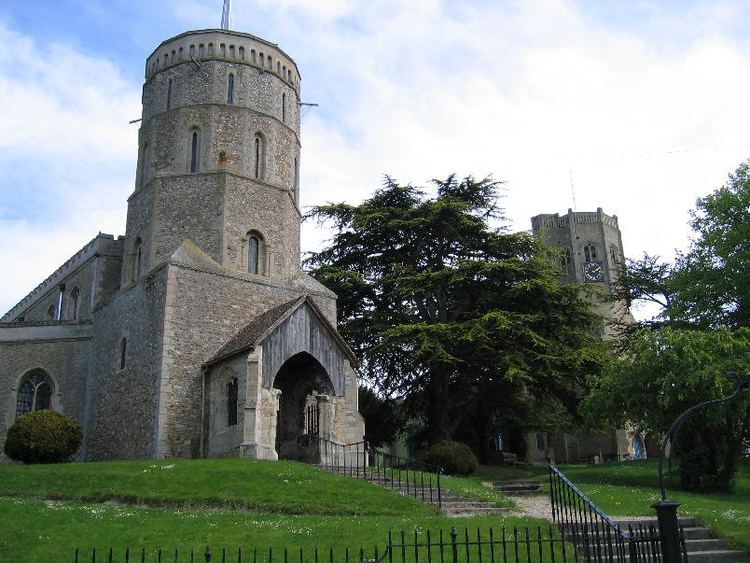Population 841 ("2011Census") Sovereign state United Kingdom Area 19.74 km² Dialling code 01638 | OS grid reference TL567639 Post town CAMBRIDGE Local time Sunday 1:05 AM | |
 | ||
Weather 7°C, Wind W at 6 km/h, 93% Humidity | ||
Swaffham prior from the air
Swaffham Prior is a village in East Cambridgeshire, England.
Contents
- Swaffham prior from the air
- Map of Swaffham Prior Cambridge UK
- Windmills of cambridgeshire swaffham prior foster s mill
- Churches
- Village History and Background
- Geology
- Demography
- References
Map of Swaffham Prior, Cambridge, UK
Lying 5 miles west of Newmarket, and two miles south west of Burwell, the village is often paired with its neighbour Swaffham Bulbeck, and are collectively referred to as 'The Swaffhams'. Swaffham Prior was often known as Great Swaffham in past centuries. It should not be confused with the town of Swaffham in Norfolk.
Children initially attend the Swaffham Prior Church of England Primary School in the village and usually then go on to Bottisham Village College, a few villages across.
Windmills of cambridgeshire swaffham prior foster s mill
Churches
The village is dominated by its twin churches that have served the parish since at least the 12th century – the Church of St Mary, and the Church of St Cyriac and St Julitta (dedicated to Saint Quiricus and Saint Julietta). In 1667 a parliamentary order combined the churches under a single parish.
The church of St Mary was first built in Norman times, and over its history has at times been allowed to fall into ruin, only being fully restored at the start of the 20th century and now serving as the parish church. It contains an attractive rood screen, and is celebrated for its series of stained glass windows showing scenes from World War I.
The original church of St Cyriac and St Julitta (Cyriac's mother) was built prior to 1200, and may possibly have existed before 1066. The present chapel is a plain Gothic-style church, consisting of a small chancel and nave with three small transeptal chapels. The tower was built in the 15th century and contains 6 bells. Having fallen into disuse, in 1878 an order was received that the church be demolished, but the order was never carried out. It now serves as a hall for exhibitions and other functions. Scottish poet Edwin Muir (1887–1959) is buried here.
John George Witt, the well-known barrister and Q.C./K.C. of Victorian and Edwardian England, who was born in 1836 at Denny Abbey, Waterbeach, Cambridgeshire, was a son of James Maling Witt (1799–1870), a prosperous farmer at Waterbeach and at Queens' College Farm, Swaffham Prior. J.G. Witt lived at Swaffham Prior during much of his youth and early manhood. He died in London in 1906. J.G. Witt's uncle, Dr. George Witt (1804 - 1869), was born at Swaffham Prior and died at 22 Princes' Terrace, Hyde Park, London. He was buried at Swaffham Prior.
Village History and Background
Swaffham Prior is an old village with rich and abundant history, even mentioned in the Domesday Book as possibly 'Great Swaffham', with Swaffham Bulbeck being 'Little Swaffham'. There are many houses in the village of great age dating back to all of the last few centuries, with the 17th century being most prominent. The village is and has always been one of trade and it has a history of trade down the centuries that continues to this day in different forms. Today it could be described as a 'dormitory' village especially looking back on its far busier past – but there is still a good community here with a great local primary school and The Red Lion pub, which many in the village consider the heart of the community today. There's also a picturesque Village Hall, also hosting many village get-togethers such as feasts, village fates etc. Swaffham Prior is famous not only for its two churches which tower above the village and can be seen for miles around but also for its two windmills (one still operating as a mill) which have also long been part of village life and are iconic symbols of the village, seen on the village sign on Cage Hill.
Geology
Swaffham Prior chalk escarpment, observable only in a few places within the village is largely physically hidden from view. This local geological feature of the landscape is the chalk (local term clunch) escarpment of Swaffham Prior and it runs the full length of this East Cambridgeshire village dating back to Anglo-saxon times. The more modern sections of the village are literally built along the top of the escarpment with the older houses nestling below the cliff face backing on to the high street.
The chalk escarpment straddles two very different local eco-systems- the Cambridgeshire Fens to the west, where the land slopes down and the chalk heathland to the east, known locally as Swaffham Prior heath, part of the Greater Newmarket chalk heath, where the land height increases and plateaus into a larger area towards the east. There are views of the Cambridgeshire countryside on all sides.
As mentioned above, in a few places the ridge of the escarpment is exposed, although usually within private property. A fraction of it can be seen from the high street, opposite the parish play area.
Demography
Census counts for the village have been paired with Burwell and Reach at various times. These pairings due to boundary changes have been excluded from the table below.
